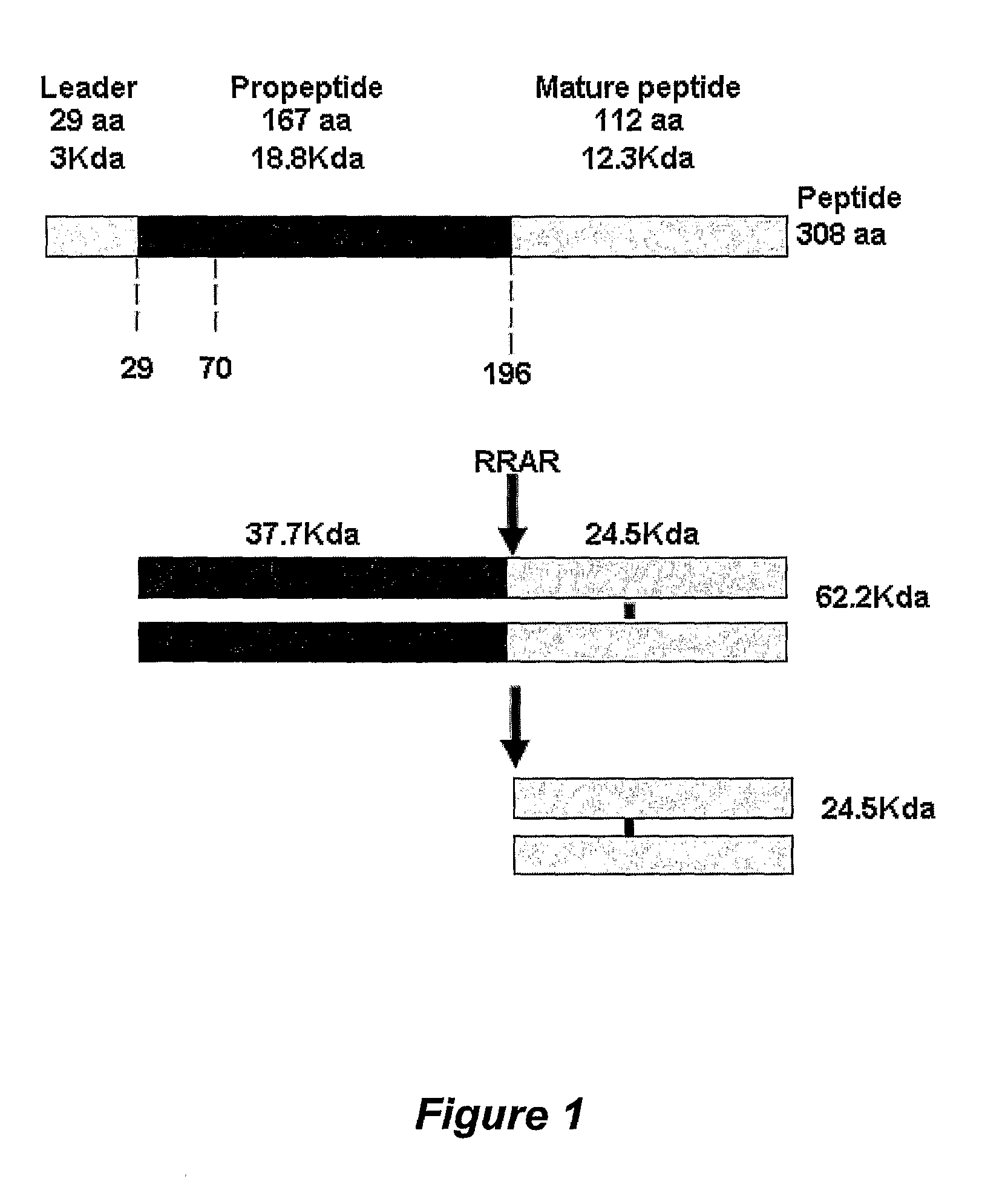Method of treating cachexia with the removal or inactivation of macrophage inhibitory cytokine-1
- Summary
- Abstract
- Description
- Claims
- Application Information
AI Technical Summary
Benefits of technology
Problems solved by technology
Method used
Image
Examples
example 1
Regulation of Serum MIC-1 Levels
[0052]MIC-1, like other members of the TGF-β superfamily of proteins, is synthesised as a precursor containing an N-terminal propeptide and a C-terminal mature MIC-1 domain. The precursor undergoes disulphide-linked dimerisation in the endoplasmic reticulum (ER) and, once dimerised, leaves the ER for the Golgi apparatus, where a furin-like convertase cleaves it at a conserved RXXR site (amino acid 196) (SEQ ID NO: 1). This cleavage removes the propeptide from the mature C-terminal domain and MIC-1 is thus released as a 24.5 kJ) disulphide linked dimer1 of the mature 112 amino acid polypeptide (FIG. 1).
[0053]It has been previously found that substantial amounts of MIC-1 are normally secreted in an unprocessed form. For example, it has been found that endogenous unprocessed proMIC-1 is secreted from a variety of cells including the trophoblast cell line BeWo4, the prostate cancer cell lines LnCAP and PC3, the pancreatic cell line Panc 1 and the monocyto...
example 2
Modulation of Appetite by MIC-1
[0059]Over the course of the investigation described in Example 1, it was noted that of the xenograft model mice, those bearing a tumour over-expressing MIC-1, either lost weight, or did not gain as much weight as control mice. Studies were therefore conducted to determine the extent and reason for the observed effect on mice weight.
Materials and Methods
[0060]The mice were weighed just before sacrifice and weight / % weight loss compared against the measured serum MICA levels (ie as determined by ELISA described in Example 1).
[0061]To assess whether serum MIC-1 levels were responsible for observed weight loss, a second study was conducted wherein nude mice were injected subcutaneously with the DU145 clone over expressing mature human MIC-1 (which had previously been associated with the highest serum MIC-1 levels) and at day 27, after the mice had lost substantial weight, injected intraperitoneally with either 1 mg or 10 mg of control purified sheep IgG o...
example 3
Weight Loss Associated with MIC-1 Secreting Tumour is Reversed by Administration of an anti-MIC-1 Monoclonal Antibody
Results and Discussion
[0066]The xenograft mouse model was established in nude mice (as described above) into whose flanks were injected either DU145 cells engineered to over-express mature MIC-1. Mice injected with DU145 cells over expressing MIC-1 started to lose weight rapidly. Administration of a single injection of a monoclonal antibody to MIC-1 (MAb26), in amounts between 0.1 and 1 mg, at day 11, caused an increase in weight, the magnitude of which, and the duration of which increased with increasing amounts of MAb26 (FIG. 8A-C). At the highest dose of approximately 1 mg, the weight had risen to the pre-xenograft level and took approximately 17 days to decrease again to the same weight as when the antibody was first administered. There was no effect of MAb26 on tumour growth (FIG. 8D-F) and untreated mice (FIG. 8G) and mice treated with phosphate buffered saline ...
PUM
 Login to View More
Login to View More Abstract
Description
Claims
Application Information
 Login to View More
Login to View More - R&D
- Intellectual Property
- Life Sciences
- Materials
- Tech Scout
- Unparalleled Data Quality
- Higher Quality Content
- 60% Fewer Hallucinations
Browse by: Latest US Patents, China's latest patents, Technical Efficacy Thesaurus, Application Domain, Technology Topic, Popular Technical Reports.
© 2025 PatSnap. All rights reserved.Legal|Privacy policy|Modern Slavery Act Transparency Statement|Sitemap|About US| Contact US: help@patsnap.com



